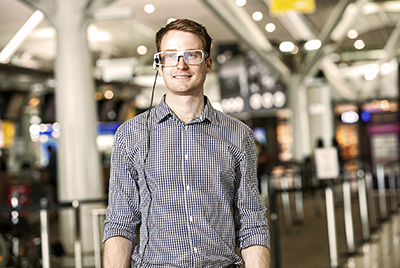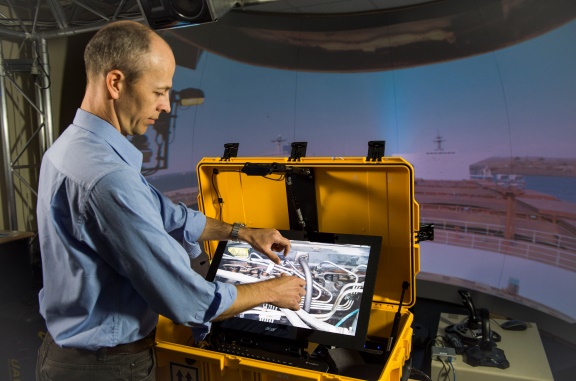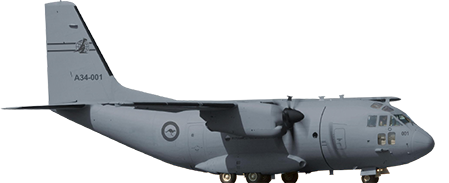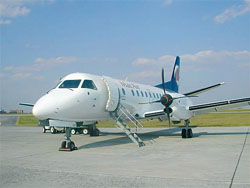IT IS an airport. It is located in the middle of the Brisbane CBD. Yet this airport that is shaping the future of air travel has no runway
The Queensland University of Technology (QUT) campus-based Airport Innovation Research (AIR) Lab and People and Systems (PAS) Lab are where the world’s future airports are being created.
“Our AIR lab runs many of the same systems a functioning airport does, including a check-in counter, security gate and command and control systems – it is just missing the runway," said Professor Prasad Yarlagadda, a smart systems expert who leads QUT’s multi-disciplinary airports R&D team.
“It’s where we're researching, designing and testing a range of innovations to better manage airports and their competing passenger, security and economic concerns.” 
QUT is at the forefront of airport research and development (R&D), spearheading international research to make airport experiences safer and faster.
For more than a decade QUT has been helping Brisbane Airport Corporation and other airports around the country through airport-related research and development.
Prof. Yarlagadda said the university built the AIR Lab to test its research because airports never sleep, which makes it difficult to conduct on-site testing without disrupting an airport’s day-to-day business. The results are proving a game-changer for airports.
Artificial intelligence and image processing specialist, Clinton Fookes, and his colleagues have designed video analytics software that uses CCTV feeds to not just spot people posing a potential security risk but to monitor how quickly passengers move through the airport.
“The video analytics tracks the overall flow and throughput of passengers through an airport – the time it takes for them to go from A to B to C – identifying bottlenecks and other issues that are slowing down arrival and departure processes,” Prof. Fookes said.
“Currently, many staff make resourcing decisions based on their own perception of the airport's status, gut feeling and limited data feeds. These video analytics gives them the real-time data they need to make the best decisions for both passengers and staff.
“Combined with our statistical modelling software, this technology provides an unprecedented level of business intelligence to help the various airport agencies make sure your airport experience runs as smoothly as possible.
“And more importantly, when it isn't running smoothly, this technology helps airport staff to detect that, and to understand why.”
That statistical modelling software, developed by Jegar Pitchforth as part of his PhD, has already been trailed at the Brisbane International Airport alongside with the video analytics which have been running live and in real-time.
The software takes the massive amount of data traditionally collected by various airport sections and displays it in a way that shows how the work in one area impacts on others.
It allows staff to predict the impact of a particular decision or event, identify the root cause of a particular issue and calculate which factors influence a particular outcome an airport is striving for.
“Essentially our statistical modelling system tells an unfolding story about what's happening at the airport at any given moment in time and – importantly – provides a snapshot of the immediate and near future,” Prof. Fookes said.
“If, for example, an aircraft is going to arrive either early or late, the airport and border agencies can find out what impact that will have on their workload and can better adjust their resources to meet the changes in demand when they need to.”
Prof. Yarlagadda and his multi-disciplinary team of chief investigators including professors Clinton Fookes, Kerrie Mengersen and Sridha Sridharan will continue this research for another three years with funding from Australian Research Council's Linkage Scheme.
They are collaborating with Brisbane Airport Corporation, airport service providers and other QUT academics to take previous research to the next level.
Across the campus from the AIR Lab, QUT design research experts in the PAS Lab are using unique passenger-focused research to change the design and operation of airport security points.
Led by director Vesna Popovic, research recommendations from the PAS Lab team has ensured passengers departing from Brisbane Airport now pass through security screening 80 per cent faster.
“Providing space for passengers before and after screening has allowed passengers to unpack baggage well in advance of screening, and sufficient time to re-pack so as not to crowd the conveyer belt,” Prof. Popovic said.
“Having personnel help passengers in these processes also speeds things up because people typically don’t read signs at this point in their airport journey.
“These simple measures have lowered the airport’s operational costs by 20 percent because there has been an increase in passenger throughput from 260 passengers an hour to 340 an hour.
“PAS Lab researchers are using eye-tracking technology for two separate projects – security screening and intuitive navigation at the airports.
“We’ve also identified the different strategies both experienced and novice screeners use when checking baggage to help the novice staff get up to speed quickly, and have discovered that putting security screeners on a 10-minute rotation maximised their concentration levels.”
Prof. Popovic recently received an Australian Research Council Linkage Scheme grant to investigate automated methods to monitor security operator knowledge and engagement, to assess the real-time security screening context, and to detect unusual passenger behaviour at the screening check-point.
The research team also includes professors Fookes, Yarlagadda, Sridha Sridharan, Thea Blackler and Nara Srinavasan (Edith Cowan University) and Dr Ben Kraal.
“This monitoring will provide new knowledge and techniques to enhance security operator performance, refine the screening process, improve passenger experience and, most critically, ensure safety at our airports,” Prof. Popovic said.
In the most comprehensive study of its kind, QUT researchers are using Tobii eye-tracking glasses to understand exactly what passengers look at and focus on while moving through airport terminals.
PhD industrial design researcher Andrew Cave said the project will help his team simplify the way-finding experience for passengers by making navigating airports more intuitive.
“The less time passengers spend being lost and confused the better their airport experience will be,” Mr Cave said.
“One aspect to this project is ensuring passengers get to their boarding gate on time, because delayed flights due to missing passengers can be costly for airlines, airports and passengers alike.”
QUT experts have created a sophisticated, interactive computer system that allows airport staff to better coordinate responses to emergency situations. They are also developing new biometrics technology that could eliminate long queues, and an interactive ‘multi-touch’ command and control table that will be used to plan and manage emergency scenarios.
www.qut.edu.au
About AIR Lab
Championed by Professor Prasad Yarlagadda, and Brisbane Airport Corporation's General Manager (Operations) Stephen Goodwin, AIR Lab was developed with joint funding from research partners The Australian Research Council, QUT, the University of Technology Sydney and the University of Melbourne. Housed in QUT's Science and Engineering Faculty, the AIR Lab was developed to test the outcomes of airport research before those outcomes are deployed to airports, and to help train airport personnel.
About PAS Lab
The PAS Lab, within the Creative Industries Faculty's School of Design, has been championed by Professor Popovic with initial support from QUT and has developed over eight years, achieving a national and international reputation in the following focused areas of research:
- intuitive interaction
- experience and expertise
- context-of-use.
Its mission is to research people's experiences with systems, product, activities and services and apply those findings to their design.
ends


 How to resolve AdBlock issue?
How to resolve AdBlock issue? 


